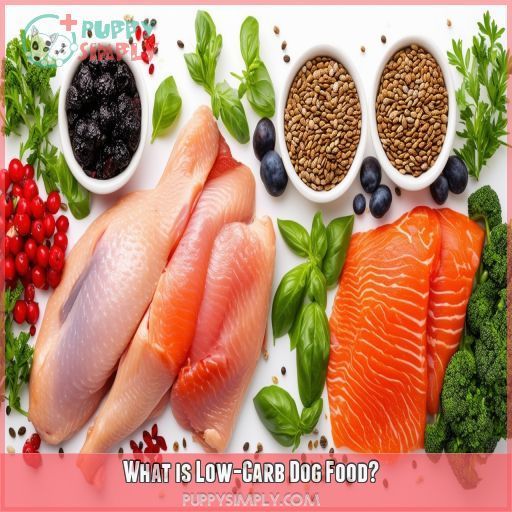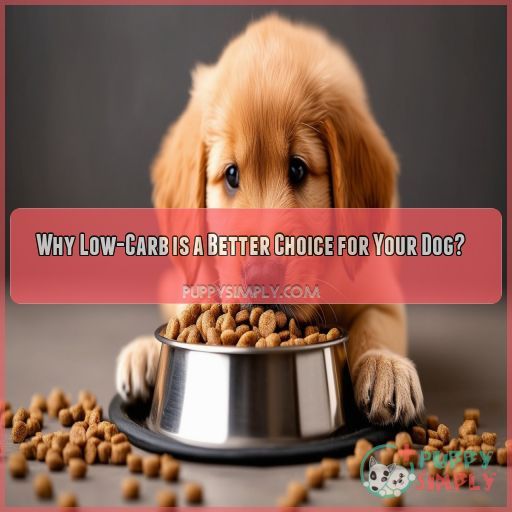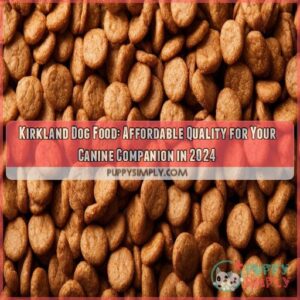This site is supported by our readers. We may earn a commission, at no cost to you, if you purchase through links.
 Low-carb dog food can be a game-changer for your furry friend’s health. It typically contains less than 30% carbohydrates, focusing instead on protein and healthy fats.
Low-carb dog food can be a game-changer for your furry friend’s health. It typically contains less than 30% carbohydrates, focusing instead on protein and healthy fats.
This diet can help manage your dog’s weight, reduce inflammation, and even boost their energy levels. Many low-carb options include nutrient-rich ingredients like garden vegetables and lean meats.
Top brands like The Farmer’s Dog and ORIJEN offer excellent low-carb choices, catering to different needs and budgets.
By switching to a low-carb diet, you’re not just feeding your dog; you’re investing in their long-term health and happiness.
Curious about which low-carb food might be the perfect fit for your canine companion?
Table Of Contents
- Key Takeaways
- What is Low-Carb Dog Food?
- Why Low-Carb is a Better Choice for Your Dog?
- A Quick Look at the Winners of 2024
- 10 Best Low-Carb Dog Foods
- 1. Orijen Six Fish Grain Free Dog Food
- 2. Wellness Core Puppy High Protein
- 3. Merrick Grain Free Chicken Sweet Potato
- 4. Victor Purpose Nutra Pro Dog Food
- 5. AvoDerm Weight Support Dog Food
- 6. Solid Gold Nutrientboost Barking Beef
- 7. Visionary Pet Foods Keto Dog Food
- 8. Epigen 90 Dog Cat Food
- 9. Taste Of The Wild High Prairie
- 10. Purina Overweight Management Wet Dog Food
- Frequently Asked Questions (FAQs)
- What is low carb dog food?
- What foods are lowest in carbohydrates?
- How do I choose a low-carb dog food?
- What is a low-carb dog diet?
- What is the best low-carb dry dog food?
- What are the benefits of low carb dog food?
- How does low-carb dog food affect dental health?
- Can puppies safely eat low-carb dog food?
- Are there any breed-specific considerations for low-carb diets?
- How long does it take to see results?
- Can homemade diets be low-carb for dogs?
- Conclusion
Key Takeaways
- Low-carb dog food is like a secret weapon for your pup’s health, packing a protein punch while keeping those pesky carbs at bay (less than 30%). It’s the canine equivalent of trading in donuts for dumbbells!
- From managing your furry friend’s waistline to giving them an energy boost that’ll make the Energizer Bunny jealous, low-carb diets can work wonders. Who knew cutting carbs could turn your couch potato into a canine athlete?
- Top dog food brands are jumping on the low-carb bandwagon faster than you can say "fetch." The Farmer’s Dog and ORIJEN are leading the pack with tasty options that’ll have your pup doing backflips at mealtime.
- Choosing the right low-carb chow for your four-legged friend isn’t rocket science, but it does require some tail-wagging research. Keep an eye out for high-quality proteins, garden veggies, and watch those carbs melt away like ice cream on a hot summer day.
What is Low-Carb Dog Food?
Low-carb dog food focuses on providing nutrition with minimal carbohydrate content. It typically contains less than 30% carbohydrates, prioritizing low-carb benefits like weight management and reduced inflammation. These diets use high-quality protein as the main ingredient, making it suitable for both puppies and seniors.
Healthy low-carb ingredients include garden vegetables, fruits, and whole grains such as quinoa and millet, ensuring your dog receives essential nutrients without excessive carbs. Unlike high-carb diets that can exacerbate obesity and other conditions, low-carb dog food supports lean muscle and promotes energy.
When choosing dry dog food, a grain-free, low-carb based diet is ideal to keep your furry friend healthy and active (Source).
Why Low-Carb is a Better Choice for Your Dog?
Switching to low carb dog food can work wonders for your furry friend’s health. Reducing carbs in their diet can:
- Decrease Inflammation: Low-carb diets help alleviate digestive issues and reduce overall inflammation.
- Manage Weight: They lower the risk of obesity, making it easier to manage your dog’s weight.
- Minimize Allergens: These foods cut down on potential allergens found in high-carb treats.
- Boost Energy: Your dog will have more energy for growth and activity.
Prioritizing low-carb dog foods designed to fit your dog’s needs ensures balanced nutrition while protecting against conditions like heart disease and kidney disease .
A Quick Look at the Winners of 2024
When choosing low-carb dog food in 2024, consider top picks like The Farmer’s Dog Chicken Fresh Dog Food, ORIJEN Original Amazing Grains, Visionary Pet Foods Keto Low Carb Dry Dog Food, ORIJEN Tundra Grain-Free Dry Dog Food, and Ketona Chicken Dry Dog Food for your dog’s health and happiness.
These options stand out as leading choices in providing balanced nutrition and promoting overall well-being for your furry companion.
The Farmer’s Dog Chicken Fresh Dog Food – Best Overall
For the best overall pick in low-carb dog food, consider The Farmer’s Dog Chicken Fresh Dog Food. This subscription-based delivery service offers fresh food benefits with high-quality dog food ingredients. Ethically sourced chicken meets your dog’s nutritional requirements, promoting a healthy weight. Plus, it avoids complex carbohydrates and includes omega-3 fatty acids for optimum health.
ORIJEN Original Amazing Grains – Budget Buy
ORIJEN Original Amazing Grains offers an outstanding balance of quality and budget-friendly dog food. This high-protein dog food is packed with premium ORIJEN ingredients, providing excellent nutritional value. The grain-inclusive dog food features ancient grains, adding fiber and nutrients without the drawbacks often seen in grain-free diets. It’s a superb natural dog food option that doesn’t break the bank .
Visionary Pet Foods Keto Low Carb Dry Dog Food
Visionary Pet Foods Keto Low Carb Dry Dog Food is an excellent choice for a ketogenic diet. It helps in obesity management and mimics an ancestral diet. This dry food option uses superfood ingredients providing numerous benefits.
- Supports weight management
- Reduces inflammation
- Enhances energy levels
- Decreases potential allergens
This makes it one of the best low-carb dog foods available .
ORIJEN Tundra Grain-Free Dry Dog Food
ORIJEN Tundra Grain-Free Dry Dog Food is renowned for its exceptional nutritional content and palatability. Crafted with ingredients like ranch-raised venison and duck, it supports dogs with inflammatory conditions and food sensitivities. The kibble size suits all breeds, enhancing brand reputation and customer satisfaction.
| Feature | Detail |
|---|---|
| Protein Source | Venison, Duck |
| Carb Content | Low Glycemic Index |
| Customer Rating | High satisfaction |
This food promotes overall wellness and is a top pick for health-focused pet owners .
Ketona Chicken Dry Dog Food
Ketona Chicken Dry Dog Food is another top contender. It stands out for its low-carb content and high-quality ingredients. Ideal for dogs with chicken allergies or dry skin, Ketona provides alternative proteins and is grain-free, supporting dogs with inflammatory bowel disease. Although it’s an expensive brand, it reduces risks of heart and kidney disease .
10 Best Low-Carb Dog Foods
Explore the top picks for low-carb dog food, including Orijen Six Fish Grain Free, Wellness Core Puppy High Protein, Merrick Grain Free Chicken Sweet Potato, Victor Purpose Nutra Pro, and more. These selections offer balanced nutrition to support your dog’s health and well-being.
1. Orijen Six Fish Grain Free Dog Food

Orijen Six Fish Grain-Free Dog Food is a powerhouse of nutrition for your dog. This biologically appropriate diet includes up to 85% animal ingredients like whole mackerel and herring, providing a rich source of protein, vitamins, and minerals. It’s designed to support your dog’s immune system, skin, coat, and digestion, making it ideal for overall health.
While it may cause loose stools in some dogs, its premium ingredients and nutritional benefits make it a strong choice for many pet owners .
Best For: Dogs at all life stages (except growing large breed dogs, 70 lbs. or more as an adult) seeking a nutrient-rich diet to support their overall health.
- Up to 85% animal ingredients from a variety of fish
- Supports immune system, skin, coat, and digestion
- Biologically appropriate diet
- May cause loose stools in some dogs
- Some users have reported that pieces were stuck together in the shipment
- May not be suitable for dogs with allergies to fish or other ingredients
2. Wellness Core Puppy High Protein
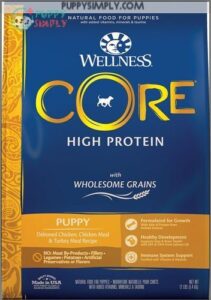
Wellness Core Puppy High Protein dog food is perfect for fostering whole body health in your young dog. It’s loaded with protein-rich deboned chicken, turkey meal, and nutrient-packed superfoods like quinoa and blueberries.
Fortified with omega fatty acids, antioxidants, glucosamine, probiotics, and taurine, it supports lean body mass, muscle tone, and a healthy coat. This dry food, crafted for puppies of all breeds, prioritizes natural nutrition while being high-protein and low-carb, making it an excellent choice for ideal puppy growth .
Best For: Puppies of all breeds seeking whole body health and ideal growth.
- Rich in protein from deboned chicken and turkey meal
- Fortified with omega fatty acids, antioxidants, and glucosamine for overall well-being
- Supports lean body mass, muscle tone, and a healthy coat and skin
- Not suitable for dogs with grain allergies
- May be more expensive than some other puppy foods
- Strong odor due to the inclusion of natural ingredients
3. Merrick Grain Free Chicken Sweet Potato

Merrick Grain Free Chicken Sweet Potato Recipe is an excellent choice for your dog, offering high-quality protein as its first ingredient.
This grain-free, low-carb formula is crafted to support lean muscle mass and contains omega-3 and -6 fatty acids for a healthy coat.
With glucosamine and chondroitin, it promotes joint health while avoiding artificial additives. However, some dogs with sensitivities might react to grain-free diets.
Best For: Dogs with sensitivities to grains and those seeking a high-protein diet with joint support.
- High protein content (57%) from animal sources
- Grain-free formula for easy digestion
- Glucosamine and chondroitin for joint health
- May have undergone recipe change, affecting appearance and digestibility
- Some dogs may have sensitivities to grain-free diets
- May be more expensive than similar products
4. Victor Purpose Nutra Pro Dog Food
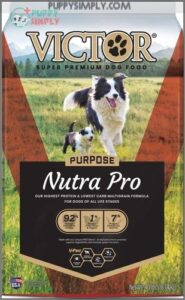
Victor Purpose Nutra Pro Dog Food offers a nutrient-dense recipe with 92% meat protein, designed for dogs with moderate to high activity levels.
This high-protein, low-carb food is grain-free and free from corn, wheat, and soy.
It’s ideal for puppies, pregnant, or lactating females and supports shiny coats, less shedding, and improved stool quality.
With its high-quality ingredients, this food caters to all breeds and life stages, making it a versatile option for your furry companion.
Best For: Dogs with moderate to high activity levels, puppies, pregnant or lactating females, and dogs with food sensitivities.
- High in protein, low in carbs
- Grain-free, gluten-free, and free from corn, wheat, and soy
- Provides sustained energy and supports a shiny coat
- Temporarily unavailable due to a salmonella scare
- Expensive
- Not suitable for dogs with chicken allergies
5. AvoDerm Weight Support Dog Food
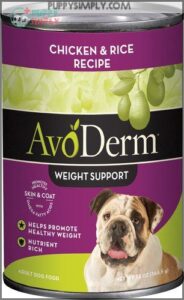
AvoDerm Weight Support Dog Food is your go-to for maintaining your dog’s healthy weight and supporting a lustrous coat. Its formula, rich in omega-3 and -6 fatty acids from avocado, provides balanced protein and fat levels without corn, wheat, or soy.
Naturally preserved with mixed tocopherols, it includes antioxidant nutrients that bolster immune health.
Suitable for adult dogs of all breeds, AvoDerm helps keep your furry friend in top shape with every meal .
Best For: Adult dogs of all breeds who need help maintaining a healthy weight and supporting a lustrous coat.
- Provides healthy, balanced levels of protein, fat, and nutrients
- Naturally preserved with mixed tocopherols
- Antioxidant nutrients added to support a healthy immune system and overall wellness
- 9 out of 12 cans were not completely full
- Not suitable for puppies or dogs with certain allergies
- May be more expensive than other dog foods
6. Solid Gold Nutrientboost Barking Beef
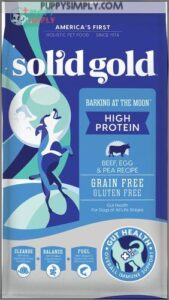
Looking for a protein-packed, low-carb option for your pup? Solid Gold Nutrientboost Barking Beef might be your answer. With beef as the first ingredient, this grain-free formula is designed to support your dog’s overall health.
It’s packed with probiotics for gut health and includes a blend of superfoods like blueberries and cranberries. Made in the USA, it’s suitable for all life stages and breeds.
Keep in mind, though, that it may not be ideal for dogs with food sensitivities, and any formula change could cause temporary digestive issues in some pups.
Best For: Dogs of all life stages and breeds looking for a protein-packed, low-carb option.
- High in protein
- Probiotic support for gut health
- Contains prebiotics and 90 million probiotics per pound
- May not be suitable for dogs with food sensitivities
- Formula change may cause digestive issues in some dogs
- Not suitable for dogs with grain allergies
7. Visionary Pet Foods Keto Dog Food
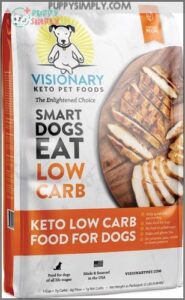
If you’re looking for a truly low-carb option, Visionary Pet Foods Keto Dog Food might be your best bet. With only 3% carbohydrates, it’s designed to mimic a dog’s ancestral diet.
This food is packed with high-quality chicken and beneficial fats, promoting lean muscle growth and overall health. It’s grain-free and gluten-free, making it ideal for dogs with sensitivities.
Many pet owners report seeing improvements in their dogs’ coats, energy levels, and digestion.
However, it’s important to introduce gradually and consult your vet, especially if your dog has a sensitive stomach or specific health concerns.
Best For: Dogs with allergies, skin issues, digestive problems, or who need a low-carb diet.
- High-quality chicken and beneficial fats
- Grain-free and gluten-free
- May improve coat, energy levels, and digestion
- May not be suitable for dogs with sensitive stomachs
- Kibble may be too large for some dogs
- May not be suitable for diabetic dogs
8. Epigen 90 Dog Cat Food
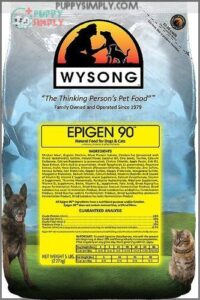
Epigen 90 Dog Cat Food offers an ultra-high protein diet that’s perfect for your furry friend. With 63% protein content, it’s designed to mimic your dog’s natural diet.
You’ll appreciate the starch-free formula, packed with chia seeds, apple pectin, and beneficial probiotics. It’s also rich in omega fatty acids for a healthy coat.
Made in the USA, you can serve it as a complete meal or a protein booster.
While it’s great for many dogs, keep in mind that the high protein might not suit all pups, especially those with certain health conditions.
Best For: Dogs and cats who need a high-protein diet for wellness, convalescence, strength enhancement, immune stimulation, weight loss, or protein boosting.
- Starch-free recipe mimics natural diet
- Rich in omega fatty acids for healthy skin and coat
- Made in the USA with domestically-sourced ingredients
- High protein content may not be suitable for all dogs
- May not be appropriate for diabetic cats
- Some cats and dogs experienced gastrointestinal upset
9. Taste Of The Wild High Prairie

Taste of the Wild High Prairie offers your pup a protein-rich, low-carb option that mimics their ancestral diet. With real buffalo as the first ingredient, it’s packed with essential amino acids for muscle development.
You’ll find a blend of fruits and vegetables providing antioxidants and fiber, supporting digestive health. The grain-free formula is ideal for dogs with sensitivities.
While it’s not the lowest in carbs, it’s a solid choice for active dogs needing sustained energy. Remember, the high protein content means you’ll need to adjust portion sizes to prevent overfeeding.
Always consult your vet before making dietary changes.
Best For: Active dogs needing sustained energy.
- High in protein (32%)
- Grain-free recipe
- Supports healthy digestion, immune system health, and overall health and wellness
- May cause stomach upset or weight gain
- Not the lowest in carbs
- High protein content may require adjusting portion sizes
10. Purina Overweight Management Wet Dog Food
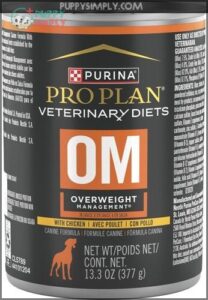
If your furry friend needs to shed a few pounds, Purina Overweight Management Wet Dog Food might be the answer. It’s packed with high-quality protein and natural fiber to keep your pup feeling full while cutting back on calories.
This low-fat formula supports lean muscle mass and immune health, thanks to its antioxidant blend. You’ll find water and chicken as the top ingredients, ensuring your dog gets the nutrition they need without excess carbs.
It’s versatile too – use it for weight loss or maintenance.
Just remember, consult your vet before making any significant changes to your dog’s diet.
Best For: Overweight or obese dogs looking to lose or maintain weight.
- High-protein, low-calorie, and low-fat formula
- Rich in natural fiber to promote satiety
- Supports lean muscle mass and immune health
- May not be ideal for dogs with sensitive stomachs
- Contains some artificial ingredients
- Can be expensive compared to other wet dog foods
Frequently Asked Questions (FAQs)
What is low carb dog food?
Imagine a canine foodie’s dream: a feast that trims the fat without skimping on flavor. You’re looking at low-carb dog food, a protein-packed powerhouse that’ll keep your furry friend lean and mean, without the carb overload.
What foods are lowest in carbohydrates?
You’ll find the lowest carbs in meat-based options like lean chicken, turkey, and fish. Eggs are also excellent low-carb choices. For plant-based options, consider leafy greens, broccoli, and cauliflower. These foods provide essential nutrients without excessive carbohydrates.
How do I choose a low-carb dog food?
Look for foods with less than 30% carbs, prioritizing high-quality protein as the first ingredient. Check the ingredient list for healthy carbs like vegetables and fruits. Consider your dog’s age and health needs when selecting a formula.
What is a low-carb dog diet?
A low-carb dog diet limits carbohydrate intake, focusing on protein and healthy fats. You’ll feed your pup foods with fewer grains and starches, aiming for less than 30% carbs. It’s designed to mimic a dog’s ancestral diet.
What is the best low-carb dry dog food?
Imagine a feast fit for a canine king! You’ll find ORIJEN Original Amazing Grains topping the charts. It’s packed with protein, low in carbs, and contains nutritious grains. Your pup’s tail will wag with delight at this wholesome choice.
What are the benefits of low carb dog food?
You’ll see improved weight management and reduced risks of obesity-related issues. Low-carb diets can boost your dog’s energy, enhance digestion, and potentially decrease allergies. They may also help regulate blood sugar and support overall health.
How does low-carb dog food affect dental health?
Your furry friend’s pearly whites will thank you! Low-carb dog food can reduce plaque buildup, as there’s less sugar for bacteria to feed on. This may lead to fresher breath and healthier gums for your canine companion.
Can puppies safely eat low-carb dog food?
You can feed puppies low-carb food, but it’s essential to guarantee they’re getting enough nutrients for growth. Consult your vet first, as puppies have specific dietary needs. Always choose a formula designed for their life stage for maximum health.
Are there any breed-specific considerations for low-carb diets?
You’ll find breed-specific considerations for low-carb diets. Large breeds may need more carbs for energy, while small breeds often thrive on lower carb intake. Always consult your vet to tailor the diet to your dog’s unique needs.
How long does it take to see results?
Ever watched a flower bloom? Similarly, your dog’s transformation takes time. You’ll likely notice subtle changes in 2-4 weeks, with more significant results in 6-8 weeks. Consistency is key for best benefits from a low-carb diet.
Can homemade diets be low-carb for dogs?
Yes, you can create low-carb homemade diets for dogs. Focus on lean meats, healthy fats, and low-carb veggies. It’s essential to consult a veterinary nutritionist to confirm the diet’s balance and meets your dog’s specific needs.
Conclusion
Studies show that 56% of dogs in the US are overweight or obese. Switching to low-carb dog food can help address this issue while providing numerous health benefits.
You’ve now seen our top 10 picks for low-carb options, each offering unique advantages for your furry friend. Remember, the best choice depends on your dog’s specific needs and preferences.
Consult with your vet before making dietary changes, and monitor your dog’s response to the new food. With the right low-carb diet, you’re taking a significant step towards your dog’s long-term health and happiness.
- dogloversdigest.com
- dogfood.guide
- wellpet.org

